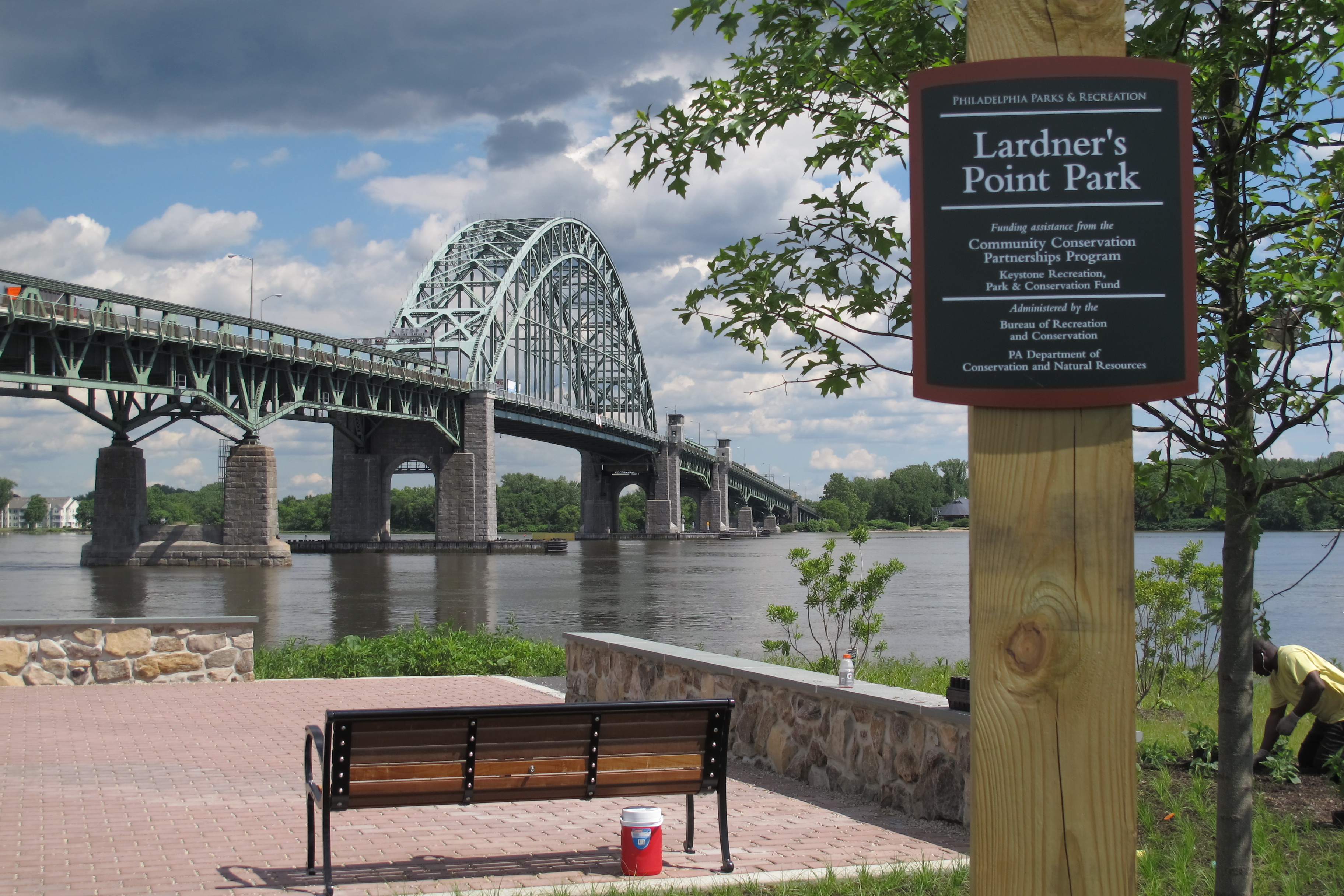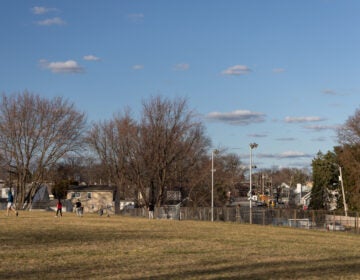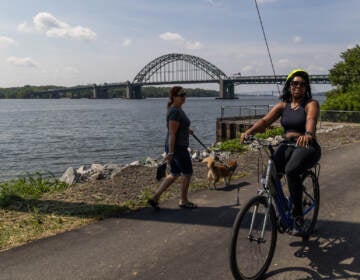Where’s the restroom? In city parks, there may be nowhere to go

Penn Treaty Park in Fishtown has no bathroom, so when a local preschool class met there for a playdate recently, the parents pulled out little travel toilets for the children. Kensington resident Clare Herlihy Dych watched with amusement as her 3-year-old daughter took a seat.
“Three kids were just sitting on these little miniature potties around a tree, going to the bathroom, which is kind of hilarious,” she recalled with a laugh.
Yet the prospect of dealing with a lack of park bathrooms in the years to come was definitely not funny to Dych. She takes her daughter to city parks frequently and has another baby on the way — travel toilets are clearly not a long-term solution. “I think about the future, and how we’ll manage things,” said Dych, a former president of the East Kensington Neighborhood Association. “Hopefully, she’ll be older and able, I guess, to leave the park to go to a coffee shop or something. You’re really at the mercy of local businesses. I would probably be less likely to go to a park if there’s not a bathroom option nearby.”
Other users of city parks and playgrounds cite the lack of restrooms as a major source of frustration, along with the poor conditions and the limited available hours of the facilities that do exist. Those issues, some say, make it particularly difficult for certain groups of people, like the elderly, to use parks. Fields and planted areas end up being used as toilets, which is unhygienic at the very least. Restrooms are among the top topics of complaints and comments to the city’s Department of Parks and Recreation, Commissioner Kathryn Ott Lovell said, matched only by comments about dog parks.
The department hopes to start renovating a few bathrooms soon as part of its Rebuild initiative, and will review its staffing patterns with an eye toward possibly extending evening and weekend hours at recreation centers and restrooms, Ott Lovell said. But substantially improving access would probably require an increase in the Parks and Recreation Department’s operating budget, which is unlikely in the near future.
As the department works to find solutions, many people remain unable to take full advantage of the city’s extensive park system, she said.
“Lack of bathrooms in parks keeps families out, and it keeps the elderly out,” as well as disabled residents and many others, Ott Lovell said. “We want people in parks. We want people in rec centers. We want them to spend the whole day there, and it’s just not feasible if there aren’t bathrooms, or the bathroom facilities aren’t well maintained. It’s a huge issue.”
The problem of restroom access is not unique to parks and playgrounds. The arrests of two black men at a Rittenhouse Starbucks in April after they asked to use the restroom without placing an order focused attention on the privatization of public space and disparities in access to various types of public facilities. Cities around the world have tried out many different solutions to the puzzle of giving residents and visitors comfortable, clean places to answer the call of nature while preventing the restrooms from being vandalized or used for criminal activity.
Philadelphia officials looked into setting up street toilets back in 2006, but at present public bathrooms are for the most part only available at parks, libraries, and train stations. Those restrooms are accessible only when the facilities are open. For parks, that generally means weekday business hours, when recreation centers are open, and Saturday morning hours at some locations. Fairmount Park and a few others also have standalone bathrooms that are open when park rangers can get to them.
In general, however, bathrooms other than seasonal portable potties are scarce. Even popular historic parks like Clark Park in West Philadelphia have no permanent restroom facilities. A recent ranking of city park systems by the Trust for Public Land, a national nonprofit, reported that Philadelphia has 11 park bathrooms per 10,000 residents, far fewer than places such as Minneapolis and Cincinnati, which both have at least 40 park bathrooms per 10,000 residents.
“There have been countless times that I have been out on a run and needed to use the bathroom or could have used a drink of water. I’ve had to end runs early because of nature calling in the middle of a run,” said Joseph Celentano, a Hawthorne resident. “I frequently run through Center City and the Schuylkill Trail, and I’ve basically mapped my runs around functional water fountains. I can’t even map them around bathrooms, considering there are no public ones on the way from my house to the trail.”
Ott Lovell said the Parks Department tried automated toilets, with disappointing results. In 2015, the city used state grant funding to install a set of composting toilets at Lardner’s Point Park in Northeast Philadelphia, with timed locks that opened the doors in the morning and locked them at night.
“Vandals would figure out what time it was supposed to lock, and they would stick a brick in it so it wouldn’t lock, and then they would have at it all night in the bathroom,” Ott Lovell said. “There was evidence of drug use, of drinking, of prostitution — evidence of that, in the bathrooms, when we went in in the morning. The hand dryer ripped off the wall, the soap dispenser ripped off the wall, the skylight broken. I mean, vandalized.”
“Unfortunately, we tried something, and it didn’t work. We thought it was going to be a great solution,” she said.
The lack of toilets has become urgent in some parks, and not just because of the discomfort of visitors. Maura McCarthy, executive director of Friends of the Wissahickon, said the number of visitors to Wissahickon Valley Park has climbed to more than 1.1 million a year, but the wooded 1,800-acre expanse in Northwest Philadelphia has only a handful of permanent toilets in addition to seasonal porta potties.
“Having five toilets to serve that constituency is really not adequate,” McCarthy said. “When we don’t have toilet facilities, people go in the woods, which can lead to surprises, but is also very bad for the environment. It adds to the general nutrient load in Wissahickon Creek, which is already compromised and has a higher-than-federally permissible nutrient load. And it’s gross.”
The city does pay contractors to set up and service portable toilets at Wissahickon Valley Park and a number of other sites every year. However, many people find them unpleasant, especially if they have not been recently cleaned and resupplied. Robert Thomas, an architect who is a board member at the Philadelphia Parks Alliance, said it’s simply impossible to have public bathrooms without people dedicated to monitoring them and keeping them in good condition.
“If you’re going to have bathrooms that are going to be open and accessible to the public, that don’t look like something out of war movie, you cannot do that without staffing,” he said. “Whether that’s through some program involving volunteers, or people who are paid, you can’t just have something out there, even a porta potty, without regular maintenance.”
Thomas pointed to Lloyd Hall Recreation Center, at the Schuylkill River Trail trailhead near Boathouse Row, as a model of a successful public restroom. The building is well-maintained and stays open until at least 8 p.m. every day, including weekends, which Thomas attributes to the presence of an adjoining, privately run café that has an incentive to keep its customers happy. To maintain other park bathrooms where there is no commercial tenant, the city could consider setting up a program that trains unemployed residents in marketable skills in exchange for having them manage restrooms, he said.
“It’s that kind of creativity that I think it’s going to take. The park department itself doesn’t have the budget to maintain the facilities in the way they’d like,” Thomas said. “Their answer to that is to lock them up, or let them exist open and be almost unusable.”
He said he wants to see the Parks Alliance work with the city and other partners to come up with a sustainable program for management of park bathrooms. Park users also may get some relief as the Parks and Recreation Department, as part of its strategic planning process, looks into possibly shifting the work schedule of its small staff toward later hours and weekends, Ott Lovell said.
“Some of our facilities are open 9 to 5, but people aren’t in parks 9 to 5. During the week, they’re in parks from 5 to 9, especially in the season. Sometimes, it doesn’t match up,” she said. “I think it’s because we’re still staffing our system the way we staffed it in the 1960s. People didn’t spend a lot of time in recreation centers on Sundays; I think they went to church and had dinner with their families. But, you know, I take my kids out on Sundays. That’s our day in the park and the playground.”
“During the summer season, it would be great to have bathrooms open 12 hours a day. It would be great. We don’t have the budget for that right now; we don’t have the staffing for that. We can barely staff our system appropriately with our current hours,” she said. “But it would be great to think about how we could get better at that.”
WHYY is your source for fact-based, in-depth journalism and information. As a nonprofit organization, we rely on financial support from readers like you. Please give today.







